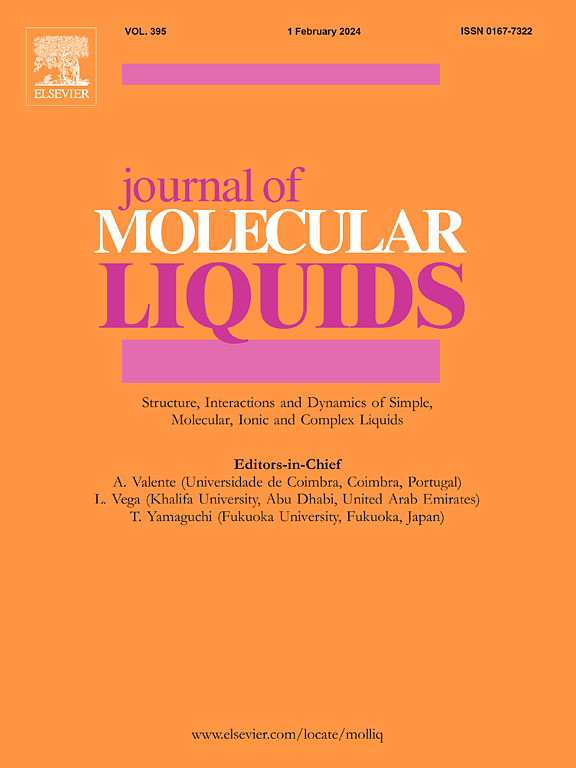Independent effects of microwave irradiation and acidic solutions on asphaltene content and upgrading of heavy crude oil
IF 5.3
2区 化学
Q2 CHEMISTRY, PHYSICAL
引用次数: 0
Abstract
This research explores the individual effects of microwave irradiation and acidic aqueous solutions on the key physicochemical properties of heavy crude oil, including asphaltene concentration, viscosity, density, and interfacial tension (IFT). Crude oil samples were treated using microwaves at 780 W (60 %) and 1300 W (100 %) for 1 to 3 min. At 1300 W, the oil temperature rose from 26 °C to 85 °C within 3 min, resulting in a 9 % reduction in asphaltene content after just 1 min of exposure. Viscosity initially increased from 377 cP to 410 cP due to light hydrocarbon evaporation but later decreased to 295 cP as heavier components such as asphaltenes and resins fragmented under microwave influence. Acidic solutions (15 % HCl) prepared with distilled water (ADW), seawater (ASW), and formation water (AFW) displayed different behaviors. ADW led to the most effective sludge reduction, while AFW, with a TDS of 215,502 ppm, exhibited the highest sludge resistance due to its ionic content (e.g., Ca2+ = 28,036 ppm, Mg2+ = 6,561 ppm). FTIR analysis revealed significant increases in S=O and C=O functional group indices, and NMR confirmed increased aromaticity and polarity after microwave and acid treatments. In terms of interfacial tension, initial IFT values dropped from 24.5 mN/m to 15.2 mN/m under acidic conditions and further to 12.1 mN/m after microwave exposure at 100 % power. However, IFT began increasing again after 3 min due to surfactant evaporation and structural reorganization. Density first increased from 0.928 g/cm3 to 0.946 g/cm3 due to light component loss, then decreased to 0.917 g/cm3 after continued breakdown of heavier molecules. Overall, microwave treatment at 1300 W for 2–3 min proved most effective for reducing viscosity and asphaltene concentration, while acidic solutions especially ADW, were more impactful in modifying IFT and reducing sludge stability.
微波辐照和酸性溶液对重质原油沥青质含量和提质的独立影响
本研究探讨了微波辐照和酸性水溶液对重质原油关键理化性质的影响,包括沥青质浓度、粘度、密度和界面张力(IFT)。原油样品在780瓦(60%)和1300瓦(100%)下用微波处理1到3分钟。在1300瓦下,油温在3分钟内从26°C上升到85°C,导致沥青质含量在暴露1分钟后降低9%。由于轻烃的蒸发,粘度最初从377 cP增加到410 cP,但后来由于沥青质和树脂等较重组分在微波影响下破碎,粘度下降到295 cP。由蒸馏水(ADW)、海水(ASW)和地层水(AFW)配制的酸性溶液(15% HCl)表现出不同的行为。ADW是最有效的污泥减量,而AFW的TDS为215,502 ppm,由于其离子含量(例如,Ca2+ = 28,036 ppm, Mg2+ = 6,561 ppm),表现出最高的污泥阻力。FTIR分析显示S=O和C=O官能团指数显著增加,核磁共振证实微波和酸处理后芳香性和极性增加。就界面张力而言,在酸性条件下,初始IFT值从24.5 mN/m下降到15.2 mN/m,在100%功率微波照射后,IFT值进一步下降到12.1 mN/m。然而,由于表面活性剂蒸发和结构重组,3 min后IFT又开始增加。由于轻组分的损失,密度先从0.928 g/cm3增加到0.946 g/cm3,然后随着较重分子的不断分解,密度下降到0.917 g/cm3。总的来说,1300瓦的微波处理2-3分钟被证明对降低粘度和沥青质浓度最有效,而酸性溶液,尤其是ADW,在改变IFT和降低污泥稳定性方面更有效。
本文章由计算机程序翻译,如有差异,请以英文原文为准。
求助全文
约1分钟内获得全文
求助全文
来源期刊

Journal of Molecular Liquids
化学-物理:原子、分子和化学物理
CiteScore
10.30
自引率
16.70%
发文量
2597
审稿时长
78 days
期刊介绍:
The journal includes papers in the following areas:
– Simple organic liquids and mixtures
– Ionic liquids
– Surfactant solutions (including micelles and vesicles) and liquid interfaces
– Colloidal solutions and nanoparticles
– Thermotropic and lyotropic liquid crystals
– Ferrofluids
– Water, aqueous solutions and other hydrogen-bonded liquids
– Lubricants, polymer solutions and melts
– Molten metals and salts
– Phase transitions and critical phenomena in liquids and confined fluids
– Self assembly in complex liquids.– Biomolecules in solution
The emphasis is on the molecular (or microscopic) understanding of particular liquids or liquid systems, especially concerning structure, dynamics and intermolecular forces. The experimental techniques used may include:
– Conventional spectroscopy (mid-IR and far-IR, Raman, NMR, etc.)
– Non-linear optics and time resolved spectroscopy (psec, fsec, asec, ISRS, etc.)
– Light scattering (Rayleigh, Brillouin, PCS, etc.)
– Dielectric relaxation
– X-ray and neutron scattering and diffraction.
Experimental studies, computer simulations (MD or MC) and analytical theory will be considered for publication; papers just reporting experimental results that do not contribute to the understanding of the fundamentals of molecular and ionic liquids will not be accepted. Only papers of a non-routine nature and advancing the field will be considered for publication.
 求助内容:
求助内容: 应助结果提醒方式:
应助结果提醒方式:


